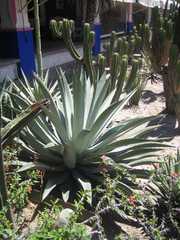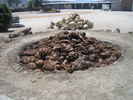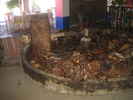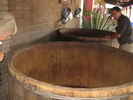Making MezcalFrom Mitla, we made our way a few miles back towards the city, where we stopped at a small restaurant, called Zapata in honor of the legendary Mexican hero, to have lunch. While we were there, we got a chance to take a tour of their Mezcal-making facilities and came to understand a little bit about the process of making Mezcal. All along the highways here, by the way, there were dozens of small, and a few larger, commercial Mezcal producers, and everywhere you looked you saw the lovely agave plants growing in small plots, about an acre or so, in fields along the highway, even surrounding a super modern factory! The process of making Mezcal is very intricate and traditional. The basic process goes something like this. First, after growing for 12-15 years, the Agave cacti are harvested. They are trimmed in the fields to their hearts which look like large pineapples, each 20-50 lbs or more. Then a large pit is dug and a fire made from local oak and pine. When the fire burns down properly, it is covered with a layer of rocks, and then the hearts of the cacti are placed in it to be cooked for several days. When they cook, they carmelize and become soft and quite sweet. We were given some pieces of the cooked Agave to chew on and they were delicious. The hearts are then crushed by a burro-drawn millstone and the sweet juice extracted. The juice is put into large open barrels to ferment. A little yeast, but NO other chemicals are added. Depending on the formula and the brewery, the fermentation can take between 2 days and 2 weeks. Once the juice is fermented it is distilled in large copper stills. There are several fractions taken off of each batch. The first stuff that comes out is something like 90% alcohol (180 proof). Then a middle layer of less strong stuff is taken off, and finally one is left with the rough body. The middle layer may be re-distilled again several times to further separate out the strong head from the body of the mixture. The final touch in making Mezcal is the recombination of the head and the body. A certain amount of the filtered body is added back into the head to produce the final mixture, which is always at least 51% alcohol, and can be much stronger! Aging is never done in wooden casks, as this would taint the flavor, but other exotic processes, including dripping the head down over a raw chicken breast (no kidding!), or the mixing in of certain herbs, serves to make specialty Mezcals of all different kinds. |




